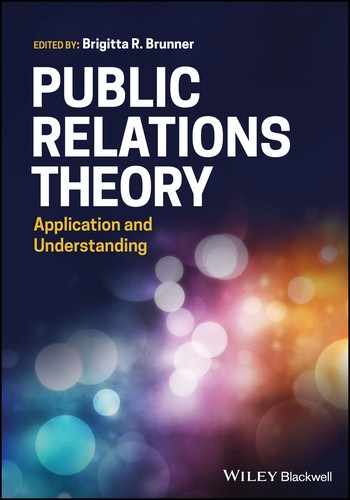Index
a
b
- biological citizenship 205
c
- Campaign for No 22–23
- catalytic model 33, 35, 38
- chaos and complexity theory 166
- charitable sector 113
- Cheong 180–181
- Chicago School of Social Thought 143, 145
- circuit of culture 55, 58, 131
- Coca‐Cola 219
- communication 16–20
- activism 159–168
- community 141–153
- crisis communication, risk communication, and issues management 31–43
- CSR 185–196
- dialogue 79–93
- diversity 49–58
- ethics 63–76
- globalization 125–136
- health 203–215
- investor relations 219–227
- media relations 175–181
- nonprofits 113–119
- political communication and government relations 233–242
- process 16, 18, 119
- social and emerging media 97–107
- strategy 13–27
- communitarianism 143–144
- community 34–36, 63–64, 99–107, 141–153, 219–221
- community‐building 141–153
- community‐building theory 146–150
- CONSOL Energy 227
- constructivism 165, 167
- coorientation theory 68
- corporate citizenship 185–186, 189
- corporate social responsibility (CSR) 79, 89–90, 185–196
- corporate stakeholder management 186–187
- corporate sustainability 185
- creating shared values (CSV) 194
- crisis communication 31–37, 41–42, 100, 117
- crisis management 32–34, 115–16, 144, 161
- critical discourse analysis, 8
- critical political economy of communication 147
- critical theory 6, 8, 146, 165–166
- cultivation theory, 5
- cultural theory of risk communication 204, 207–209, 212–213
- culture 13–14, 125–134, 142
d
e
f
g
h
i
- image repair/restoration theory (IRT) 37
- inclusion 49–51, 56–57, 147
- information subsidies 178–179, 207
- institutional theory 192
- internationalization 5, 125–126
- internet 79, 83, 88, 167, 175–176
- interpretive theory 6–7
- intersections/intersectionality 55–56
- introspective studies 222
- investor relations 6, 219–227
- issues management 31–43, 235
- issues management theory 38
l
m
n
o
p
- persuasion knowledge model 192
- political communication 233–242
- positive theory 4, 87
- postmodernism 166–167
- postpositivism 164–166
- post‐truth 72
- priming 239–242
- problem integration theory 204
- public relations 3
- activism 159–168
- community 141–153
- crisis communication, risk communication, and issues management 31–43
- CSR 185–196
- dialogue 79–93
- diversity 49–58
- ethics 63–76
- globalization 125–136
- health 203–215
- investor relations 219–227
- media relations 175–181
- nonprofits 113–119
- political communication and government relations 233–242
- process 16, 18, 119
- social and emerging media 97–107
- strategy 13–27
q
- queer theory 53–56
r
- regulation FD 220
- relationship management 33–35, 115, 119, 149, 221–222
- relationship management theory 8–9, 25, 54, 57, 117
- relationships 2–3, 7–8, 50
- activism 166
- community 141–149
- crisis communication, risk communication, and issues management 33–34
- CSR 185–190
- dialogue 79–93
- diversity 54–57
- globalization 127, 132–134
- health 210–212
- investor relations 219–225
- media relations 177–181
- nonprofits 114–119
- political communication and government relations 233–242
- social and emerging media 97–107
- strategy 13–27
- relationship theory of risk 204, 207–209, 215
- responsibility 35–37, 50–51, 64–66, 70–73, 148–149
- return on equity 220
- return on expectations 220
- rhetorical generic theory 130–131
- rhetorical paradigm 222
- rhetorical theory 223
- risk communication 31–43, 207, 212
- risk communication theory 38, 204, 207–208
- risk perception 39–41
- ROE 220
- roles theory 224–226
s
- situational crisis communication theory (SCCT) 37, 100
- situational theory of publics 133, 164–165, 212–213, 225–227
- social amplification of risk 38–42, 208
- social capital 92, 114, 141–148
- social identity theory (SIT) 52–58, 192
- social media 83–91, 97–107, 149–150, 159
- social media research 42, 99–106
- social‐mediated crisis communication model (SMCC) 100
- social media theory 103–106
- social movement organizations 161–165
- stakeholder theory 191–192, 195, 239, 241
- standpoint theory 51–58
- stealing thunder 37
- stewardship 16, 117–119
- storytelling 98–99, 107, 189, 192, 210
- strategic issues management 193
- Strategic Plans of the North and South of the Aburrá Valley 20–21
- strategy 13–26, 192, 194, 215
- synergistic model of corporate communication strategy 192
- systems theory 41, 117, 225
t
- teleology 69–70
- theory 1–9
- activism 159–168
- community 141–153
- crisis communication, risk communication, and issues management 31–43
- CSR 185–196
- dialogue 79–93
- diversity 49–58
- ethics 63–76
- globalization 125–136
- health 203–215
- investor relations 219–227
- media relations 175–181
- nonprofits 113–119
- political communication and government relations 233–242
- social and emerging media 97–107
- strategy 13–27
- theory of communicative action 54, 81
- theory of generic principles and specific applications 129–130
- theory of planned behavior 103–105, 117, 226
- theory of spillover effects 238
- third‐culture building model 130–132
- third‐party endorsement 24, 179–180
- travel industry 66
- Tylenol murders 65
u
v
w
- Waldheim, Kurt 64–65
..................Content has been hidden....................
You can't read the all page of ebook, please click here login for view all page.
